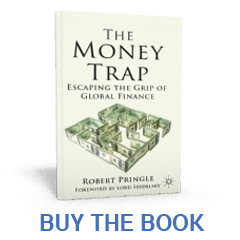The Ikon: the best world money
Reliance on central banks does not offer a way out of the debt, money and low-growth traps.
States cannot create good money. They are interested parties. A good monetary system should discipline states – i.e. hold them to account. A state-run money cannot do that. That is the flaw in proposals such as those made by Positive Money and The International Movement for Monetary Reform.
(Let me add, however, that I go along with many of the criticisms that my good friends James Robertson , Victoria Chick and others make of existing monetary systems.)
Good money is and always has been a joint venture between the state and the private sector. The State should define the monetary unit. It should maintain the value of the money unit in terms of that definition. It should have a long-term horizon. Like the monarchs in secure kingdoms and empires of old, it will aim to preserve purchase power for future generations.
Money should be an abstract represention of the common interest of the whole of society.
Long experience has shown that this can be achieved only if money is linked to something real, outside the control of governments.
A good money must also be the global standard – a standard that individual countries will voluntarily join. Only then can money’s chief benefits be obtained. Only then can the huge economies of scale be achieved.
In The Money Trap I argue that the best numeraire would be a new currency standard that I have called the “Ikon”. This refers to a basket of world equities. Everybody holding money would then have a personal stake in the future prosperity of the world and be induced, as if by an invisible hand, to work towards it.
In all other respects, money tied to global equities would behave exactly as in the gold standard. Imbalances in international payments would be adjusted without the need for a bureaucracy. Such a numeraire would immediately bring a sharp reduction in the role of bank lending and banking. Loans would become expensive to service. Companies and banks would be financed mainly by equity. States would be finance by taxation and residual borrowing in a transparent way. In fact, fixed-interest obligations of all kinds would be extremely expensive to service, causing states to reduce debt-gdp ratios.
Critics have said that this would make the general level of prices volatile, as equity prices are volatile. Yet much of this volatility is the result of sudden surges in credit and money. Equity markets fear erratic and self-sustaining booms and busts in the credit cycle – the result of unpredictable central bank monetary policies. These monetary sources of disturbance would no longer exist under such a standard. There would be no independent source of credit creation and no incentive to take up or extend credit.
It is true that “animal spirits” among entrepreneurs and investors might still generate stock market “booms”. But these are a natural part of economic growth; individuals, families and companies would grow accustomed to them and build monetary defences against any disruptive effects they may have.
The key point is that money could no longer escape into a realm of its own; the financial interest and the power of money would be narrowly restrained by the architecture of the system. Investors the world over would be able to compare real risks and returns free of the veil of money and currency fluctuations that currently make it impossible to compare real rates of return across different monetary regions and currency areas.
Monetary policies based on nation states, independent central banks, and floating exchange rates have reached their last stage of development. The doctrine of inflation targeting by independent central banks turns out to be a recipe for general financial instability. It will not survive another crisis. Nor will the current banking system. All these structures are propped up by governments/taxpayers’ money.
That experiment in central banking has reached its limits. It does not offer a way out of the debt, money and low-growth traps. The next stage of development must move beyond the limits of national level policy-making. It will (I believe) see the restoration of a system based on international cooperation, a reliable international monetary standard and stable exchange rates.
The Ikon offers the best way to benefit from financial and economic integration.
In some ways, it will be similar to the great eras of stable money. Examples are the classical gold standard and the Bretton Woods period. In other respects it will be an advance on them. It would provide a stable and reliable international monetary system for the 21st century. The alternative is a relapse into monetary anarchy, as in the period between the two world wars. Surely, nobody can want that.
I am fully aware that the world may need to endure several more crises before adopting the Ikon or some similar idea. Future crises are of course guaranteed to be produced by the present system. So that’s OK.
The idea also needs to be taken up by a big-name economist: any takers?

